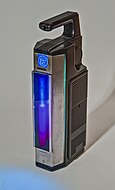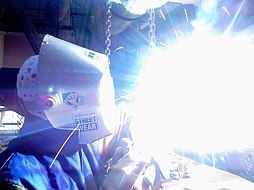Ultraviolet (UV) light is electromagnetic radiation of wavelengths of 10–400 nanometers, shorter than that of visible light, but longer than X-rays. UV radiation is present in sunlight, and constitutes about 10% of the total electromagnetic radiation output from the Sun. It is also produced by electric arcs, Cherenkov radiation, and specialized lights, such as mercury-vapor lamps, tanning lamps, and black lights.
The photons of ultraviolet have greater energy than those of visible light, from about 3.1 to 12 electron volts, around the minimum energy required to ionize atoms. Although long-wavelength ultraviolet is not considered an ionizing radiation because its photons lack sufficient energy, it can induce chemical reactions and cause many substances to glow or fluoresce. Many practical applications, including chemical and biological effects, are derived from the way that UV radiation can interact with organic molecules. These interactions can involve absorption or adjusting energy states in molecules, but do not necessarily involve heating. [citation needed] Short-wave ultraviolet light is ionizing radiation. Consequently, short-wave UV damages DNA and sterilizes surfaces with which it comes into contact.
For humans, suntan and sunburn are familiar effects of exposure of the skin to UV light, along with an increased risk of skin cancer. The amount of UV light produced by the Sun means that the Earth would not be able to sustain life on dry land if most of that light were not filtered out by the atmosphere.[1] More energetic, shorter-wavelength "extreme" UV below 121 nm ionizes air so strongly that it is absorbed before it reaches the ground.[2] However, ultraviolet light (specifically, UVB) is also responsible for the formation of vitamin D in most land vertebrates, including humans.[3] The UV spectrum, thus, has effects both beneficial and detrimental to life.
The lower wavelength limit of the visible spectrum is conventionally taken as 400 nm, so ultraviolet rays are not visible to humans, although people can sometimes perceive light at shorter wavelengths than this.[4] Insects, birds, and some mammals can see near-UV (NUV), i.e., slightly shorter wavelengths than what humans can see.[5]
- ^ "Reference Solar Spectral Irradiance: Air Mass 1.5". Archived from the original on 27 January 2011. Retrieved 12 November 2009.
- ^ Haigh, Joanna D. (2007). "The Sun and the Earth's Climate: Absorption of solar spectral radiation by the atmosphere". Living Reviews in Solar Physics. 4 (2): 2. Bibcode:2007LRSP....4....2H. doi:10.12942/lrsp-2007-2.
- ^ Wacker, Matthias; Holick, Michael F. (1 January 2013). "Sunlight and Vitamin D". Dermato-endocrinology. 5 (1): 51–108. doi:10.4161/derm.24494. ISSN 1938-1972. PMC 3897598. PMID 24494042.
- ^ Cite error: The named reference
hamblingwas invoked but never defined (see the help page). - ^ Cronin, Thomas W.; Bok, Michael J. (15 September 2016). "Photoreception and vision in the ultraviolet". Journal of Experimental Biology. 219 (18): 2790–2801. doi:10.1242/jeb.128769. hdl:11603/13303. ISSN 1477-9145. PMID 27655820. S2CID 22365933. Archived from the original on 24 June 2022. Retrieved 23 June 2022.

